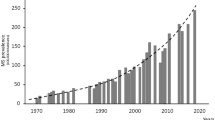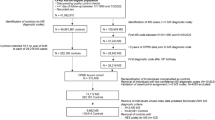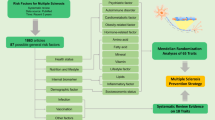Abstract
Age-adjusted multiple sclerosis (MS) mortality rates from two German states (Hesse and Baden-Wuerttemberg) that had been analyzed previously in comparison with a large number of sociogeographic variables in univariate fashion, were subjected to factor analysis. The pattern of variables associated with MS differed between both states. In Hesse, the MS mortality was associated with a setting (“factor”) reflecting a cold and damp climate related to mountainous regions dominated by coniferous forests on one hand, and with the density of butchers on the other. These findings corroborate earlier univariate correlations elsewhere, and might point to an interaction of the geoclimatic variables described, or associated features, and dietary factors related to meat, in the environmental etiology of MS. In Baden-Wuerttemberg, in contrast, a rather unique spectrum of MS-associated variables was found that could be grouped into 2 independent settings. These represented a) the Swabian Alb highland region; and b) indicators of a higher environmental burden with polyaromatic hydrocarbons associated with a higher rectal cancer mortality. “Mountains”, “forest in thinly populated area”, and agriculture were the only features that showed some association with MS in both states, but their overall agreement with the MS epidemiology in general is much weaker in comparison with the above-mentioned climatic and dietary features.
Zusammenfassung
Altersstandardisierte Mortalitätsraten für die multiple Sklerose (MS) aus zwei deutschen Bundesländern (Hessen und Baden-Württemberg), die bereits zuvor auf eine univariate Korrelation mit diversen sozialen und geographischen Variablen hin untersucht worden waren, wurden nunmehr faktorenanalytisch ausgewertet. Dabei unterschied sich das Muster der MS-assoziierten Variablen zwischen beiden Ländern. In Hessen war die MS-Mortalität mit einem Merkmalsbündel assoziiert, das unter der Bezeichnung “kühlfeuchtes Klima in von Nadelwald dominierter Bergregion” zu beschreiben wäre, und, unabhängig davon, mit der Dichte des Fleischerhandwerks. Diese Befunde bestätigen zuvor andernorts beschriebene univariate Korrelationen und könnten auf eine Interaktion zwischen den genannten geoklimatischen Variablen bzw. mit ihnen assoziierten Drittvariablen und Ernährungsfaktoren in der Ätiologie der MS hinweisen. Im Gegensatz hierzu fand sich in Baden-Württemberg ein bislang einzigartiges Muster MS-assoziierter Variabler, das sich faktorenanalytisch in 2 Bündel gruppieren lieβ. Diese repräsentierten zum einen die Schwäbische Alb als fixen geographischen Terminus, zum anderen Indikatoren einer stärkeren Umweltbelastung mit polyaromatischen Kohlenwasserstoffen; letztere waren mit der Rektumkarzinom-Mortalität assoziiert. Die Variablen “Mittelgebirge”, “Waldreichtum in dünnbesiedeltem Gebiet” und “Landwirtschaft” waren die einzigen Parameter, die in beiden Bundesländern mit der MS-Rate korreliert waren, jedoch ist ihre Assoziation mit der MS-Häufigkeit im allgemeinen wesentlich weniger konsistent als deren Bezug zu den genannten klimatischen und ernährungsbezogenen Variablen.
Similar content being viewed by others
References
Compston A, Sadovnick AD. Epidemiology and genetics of multiple sclerosis. Curr Op Neurol Neurosurg 1992; 5: 175–181.
Kurtzke JF. Epidemiology of multiple sclerosis. In: Koetsier JC, ed. Handbook of clinical neurology, vol. 3, 47. Amsterdam: Elsevier. 1985: 259–287.
Lauer K, Firnhaber W. Epidemiologische Aspekte der multiplen Sklerose. Versicherungsmedizin 1992; 44: 125–130.
Elian M, Nightingale S, Dean G. Multiple sclerosis among United Kingdom-born children of immigrants from the Indian subcontinent, Africa and the West Indies. J Neurol Neurosurg Psychiatry 1990; 53: 906–911.
Kahana E, Zilber N, Abramson JH, Bilton V, Abramsky O. Epidemiology of MS in Israel, updated (abstract). J Neurol 1992; 239 (Suppl.2): 62.
Cernacek J, Varsik P, Uiházyová D, Traubner P. The relation of geographical and meteorological factors to the occurrence of multiple sclerosis in Czechoslovakia. Acta Neurol Scand 1971; 47: 227–232.
Norman JE, Kurtzke JF, Beebe GW. Epidemiology of multiple sclerosis in U.S.veterans. 2.Latitude, climate, and the risk of multiple sclerosis. J Chron Dis 1983; 36: 551–559.
Kalafatova OI. Geographic and climatic factors and multiple sclerosis in some districts of Bulgaria. Neuroepidemiology 1987; 6: 116–119.
Acheson ED, Bachrach CA, Wright FM. Some comments on the relationship of the distribution of multiple sclerosis to latitude, solar radiation and other variables. Acta Neurol Scand 1960; 35 (Suppl.147): 132–147.
Tjazkorob A, Masiok WA, Yarosh AA. Rasprostranenje rassejannogo sklerosa w USSR. Vrachebnoe Delo 1987: 115–117.
Lauer K. Epidemiologische Charakteristika der multiplen Sklerose in Südhessen. Epidemiological symposium of the Deutsche Arbeitsgemeinschaft für Epidemiologie. Berlin, March 1993 (abstract book, p. 63).
Alter M, Yamoor M, Harshe M. Multiple sclerosis and nutrition. Arch Neurol 1974; 31: 267–272.
Swank R, Lerstad O, Ström A, Backer J. Multiple sclerosis in rural Norway. Its geographic and occupational incidence in relation to nutrition. New Engl J Med 1952; 246: 721–728.
Lauer K. Sociogeographic variables in relation to the risk of multiple sclerosis in the USA (abstract). J Neurol 1990; 237 (Suppl. 1): 102.
Lauer K. The risk of multiple sclerosis in the USA in relation to sociogeographic features: A factor-analytic approach, in Epidemiol (in press).
Nanji AA, Narod S. Multiple sclerosis, latitude and dietary fat: Is pork the missing link? Med Hypotheses 1986; 20: 279–282.
Lauer K. Multiple sclerosis in relation to meat preservation in France and Switzerland. Neuroepidemiology 1989; 8: 308–315.
Lauer K. The food pattern in geographical relation to the risk of multiple sclerosis in the Mediterranean and Near East region. J Epidemiol Comm Health 1991; 45: 251–252.
Alter M, Cendrowski W. Multiple sclerosis and childhood infections. Neurology 1976; 26: 201–204.
Compston DAS, Vakarelis BN, Paul E, McDonald WI, Batchelor JR, Mims CA. Viral infection in patients with multiple sclerosis and HLA-matched controls. Brain 1986; 109: 325–344.
Sullivan CB, Visscher BR, Detels R. Multiple sclerosis and age at exposure to childhood diseases and animals: cases and their friends. Neurology 1984; 34: 1144–1148.
Alter M, Zhen-Xin Z, Davanipour Z, Sobel E, Zibulewski J, Schwartz G, Friday G. Multiple sclerosis and childhood infections. Neurology 1986; 36: 1386–1389.
Lauer K. Sociogeographic factors and multiple sclerosis — An ecological study in 6 European countries. Neuroepidemiology 1988; 7: 122–129.
Lauer K. Risk of multiple sclerosis in relation to industrial activities: An ecological study in four European countries. Neuroepidemiology 1989; 8: 38–42.
Lauer K. Mortality of multiple sclerosis in relation to geographic factors in France. Neuroepidemiology 1990; 9: 113–117.
Lilienfeld AM, Lilienfeld DE. Foundations of epidemiology. New York: Oxford University Press. 1980.
Rothman K. Modern epidemiology. Boston: Little, Brown and Co. 1987.
Lauer K, Firnhaber W. Mortalitätsdaten zur multiplen Sklerose für das Land Hessen: Räumliche Verteilung und Korrelation mit soziogeographischen Variablen. Verh Dtsch Ges Neurol 1989; 5: 615–618.
Lauer K, Firnhaber W. Die Multiple-Sklerose-Mortalität 1973–1987 in Baden-Württemberg im Vergleich mit soziogeographischen Variablen. Nervenarzt 1992; 63: 209–212.
Backhaus K, Erichson B, Plinke W, Weiber R. Multivariate Analysemethoden. Berlin: Springer. 1990.
Complete Statistical Systems (CSS). Manual. Tucson, OK: StatSoft Inc. 1989.
Malmgren RM, Valdiviezo NL, Visscher BR, Clark VA, Detels R, Fukomoto M, Dudley JP. Underlying cause of death as recorded for multiple sclerosis patients. J Chron Dis 1983; 36: 699–705.
Malley FO, Dean G, Elian M: Multiple sclerosis and motor neurone disease: survival and how certified after death. J Epidemiol Comm Health 1987; 41: 14–17.
Petrescu A, Verdes F. Epidemiology of multiple sclerosis in Romania. Rev Roum Med Neurol Psychiatr 1989; 27: 261–271.
Jedlicka P, Hanzal F. Epidemiologic roztrousene sklerózy mozkomízní v ceske socialistické republice. Cs Neurol Neurochir 1986; 49: 390–396.
Amprino D, Barnaba A, Delia Rosa A, Lisanti F, Megna G. Ricerca epidemiologica sulla sclerosi multipla nella provincia di Bari. Acta Neurol (Napoli) 1977; 32: 818–832.
Bartschi-Rochaix W. Multiple Sklerose im Wallis. Bern: H. Huber. 1977.
Humlum J. Kulturgeografisk atlas, vol 2. Copenhagen: Gyldendal. 1971.
Ries LW, Klapp E, Haring F. Pareys Landwirtschaftslexikon, 7th ed., vol 1. Hamburg: P. Parey. 1956.
Lauer K. Dietary changes in temporal relation to multiple sclerosis in the Faroe Islands: An evaluation of literary sources. Neuroepidemiology 1989; 8: 200–206.
Lauer K. Environmental nitrophenols and autoimmunity. Mol Immunol 1990; 27: 697–698.
Draudt HN. The meat smoking process. A review. Food Technology 1963; 17: 85–90.
Di Guardo G. Potential human health risks associated with animal retroviruses: some hypotheses. Med Hypotheses 1989; 29: 195–198.
Clausen J, Hoff-Jörgensen R, Rasmussen HB. Antibody reactivity against animal retroviruses in multiple sclerosis. Acta Neurol Scand 1990; 81: 223–228.
Weinshenker BG, Dekaban G, Rice GPA. Retroviruses and multiple sclerosis. I.Analysis of seroreactivity by Western blot and radioimmune assay. Neurology 1990; 40: 1251–1253.
Lauer K. Krebsmortalität und Schadstoffbelastung des Trinkwassers: Eine ökologische Studie für das Land Baden-Württemberg. In: van Eimeren W, Überla K, Ulm K, eds. Gesundheit und Umwelt. Berlin: Springer. 1991: 105–109.
Pálffy G. MS in Hungary. In: Battaglia MA, Crimi G, eds. An update on ultiple sclerosis. Bologna: Monduzzi. 1989: 293–297.
World Health Organization of the United Nations. Guidelines for drinkingwater quality. Geneva: WHO. 1984.
Borneff J, Kunte H. Vorkommen und Bewertung von natürlichen polyzyklischen aromatischen Kohlenwasserstoffen. In: Aurand K, ed. Bewertung chemischer Stoffe im Wasserkreislauf. Berlin: E. Schmidt. 1981: 213–218.
Lauer K. The distribution of multiple sclerosis and 7 malignancies: a comparison in 12 regions. 8th ECTRIMS Congress, Barcelona (Spain), October 1992 (abstract book, p.61).
Author information
Authors and Affiliations
Rights and permissions
About this article
Cite this article
Lauer, K. A factor-analytical study of the multiple sclerosis mortality in Hesse and Baden-Wuerttemberg, Germany. Z. f. Gesundheitswiss. 1, 319–327 (1993). https://doi.org/10.1007/BF02959681
Issue Date:
DOI: https://doi.org/10.1007/BF02959681
Keywords
- multiple sclerosis
- epidemiology
- multiple sclerosis
- etiology
- polyaromatic hydrocarbons
- rectal cancer
- epidemiology




